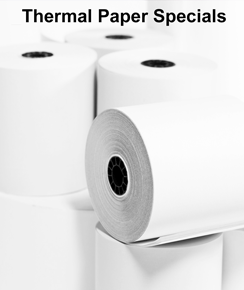Different Types of Thermal Paper
 Selecting the right type of thermal paper for receipts, packing lists, invoices, delivery documents and other purposes is extremely important. Direct thermal material is created in a much different manner than standard paper that is used in traditional printers. It includes certain chemicals that create images when heat is applied. There are several synthetic and paper formulations to choose from. Even though they may appear similar, the chemical make-up of each material affects its ability to resist moisture, heat and other types of external factors.
Selecting the right type of thermal paper for receipts, packing lists, invoices, delivery documents and other purposes is extremely important. Direct thermal material is created in a much different manner than standard paper that is used in traditional printers. It includes certain chemicals that create images when heat is applied. There are several synthetic and paper formulations to choose from. Even though they may appear similar, the chemical make-up of each material affects its ability to resist moisture, heat and other types of external factors.
In order to figure out what type of material is needed for the application, you have to consider the environment that document is going to be in after it is printed and how long it should be readable.
Important Considerations when Selecting Thermal Paper
By definition, thermal media is heat sensitive. This means that heat, light, and other types of environmental and storage conditions may affect the paper’s performance. There are several types of thermal paper, as well as synthetic stocks and coatings that are available. These offer varying degrees of protection from degradation resulting from abrasion, moisture, light, and heat.
When selecting the right type of paper for your needs, there are a few more things to consider, as well.
Heat
Some issues may occur if a document is going to be used or stored in a location where temperatures are more than 140 degrees Fahrenheit. While that may seem like plenty of heat resistance since most stores are kept at temperatures lower than this, if documents are left in vehicles, the temperatures may easily exceed this amount. As a result, the paper may be completely destroyed if in this environment. If you know there is a chance of the paper being in areas of high temperatures, then it is best to purchase thermal materials specially designed to withstand these higher temps.
Moisture
When exposed to moisture, there is some thermal paper that may not perform as expected, or there may be issues reading it. The good news is, there are specific types of materials and coatings that offer protection from moisture; however, even the best products are still going to be limited when it comes to this type of protection.
If you know that the paper is going to be exposed to moisture, then you need to find a paper made with a polypropylene film or some other type of waterproof solution.
Thickness
In the U.S., the thickness of the thermal paper is typically expressed in mils. Each mil equals 1/1000th of an inch. The thicker the material, the more durable and higher quality the paper is; however, it also means there is less paper on each roll. Make sure to consider this when making a purchase.
Thermal paper has come a long way in recent years. There are now more options than ever before. If you want to ensure you find the right type for your needs, you need to consider all the features available. Taking the time to do this will pay off and ensure you get exactly what you need.



